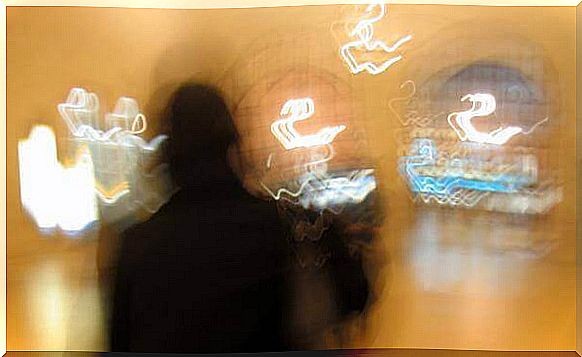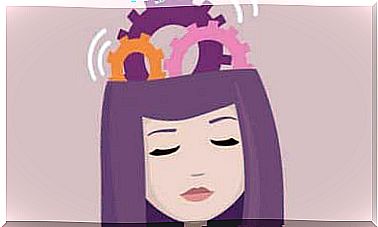Depersonalization Disorder: Who Am I Really?

“My thoughts don’t seem to be mine”, “Who am I?”, “I don’t recognize myself in the mirror”. These types of thoughts commonly occur in people with depersonalization disorder. They also occur in people who experience times of great anxiety.
The search for our own identity and our place in the world is a constant. We have all wondered at one time or another who we are, where we come from and where we are going. This is quite normal. However, these questions occur much more frequently and intensely in people with depersonalization disorder.

What is depersonalization?
Depersonalization disorder is characterized by persistent or recurring episodes of depersonalization, derealization, or both. However, what is depersonalization? Episodes of depersonalization are times when a feeling of unreality, strangeness or estrangement from oneself in general emerges.
The person suffering from depersonalization may feel independent of their whole being (eg, “I am nobody”, “I have nothing of me”). The person may also feel subjectively separated from aspects of the self. This can include feelings (for example, low emotivity: “I know I have feelings but I cannot feel them”).
Feeling separate from the self also includes feeling a separation with one’s own thoughts (eg, “my head is full of cotton wool”), body parts, the whole body, or sensations (eg, touch, proprioception. , hunger, thirst, libido). It is also common for the sense of reality to be diminished.
For example, the person experiences a robotic sensation, similar to that of an automaton, which has no control over its own words or movements. The experience of depersonalization can sometimes be that of a divided self, with an observer and a participant. This is what we call the “out-of-body experience” when it occurs in its most extreme form.
The unitary symptom of “depersonalization” is made up of several factors. These factors include abnormal bodily experiences (eg, unreality of the ego and alterations in perception), physical or emotional numbness, and time distortions with abnormal subjective memory.

What is derealization?
Episodes of derealization are characterized by a feeling of unreality or alienation or ignorance of the world. The person may feel as if in a dream or a bubble, as if there is a veil or a wall of glass between them and the world around.
The environment can be seen as artificial, colorless or lifeless. Derealization is usually accompanied by subjective visual distortions. These can be blurred vision, increased visual acuity, amplification or reduction of the visual field, two-dimensionality or flatness, exaggeration of three-dimensionality, etc. There may also be alterations in distance or the size of objects (for example, macropsy or micropsy).
Macropsia is characterized by seeing objects in a size larger than what they really are. The micropsy, on the other hand, is characterized by its opposite, in other words by the fact of perceiving objects smaller than they actually are.
Derealization can also result in hearing distortions, silencing or emphasizing voices or sounds. Diagnosis of this disorder requires the presence of clinically significant discomfort or deterioration in social, occupational, or other areas.
It should be noted that for this disorder to be diagnosed, the changes mentioned above can in no way be the result of drug use, medication, or disease (such as epilepsy). These changes should also not be a criterion for schizophrenia, panic disorder, major depression, acute stress disorder or post-traumatic stress disorder.
What other characteristics do people with depersonalization / derealization disorder have?
People with depersonalization / derealization disorder may have difficulty describing their symptoms and may think they are crazy or are going crazy. Another common experience is the fear of suffering irreversible brain damage.
A common symptom is the subjective alteration of the notion of time (eg, too fast, too slow), as well as a subjective difficulty in vividly remembering memories of the past and seeing them as proper.
Weak bodily symptoms, such as a headache, tingling, or fainting are not uncommon. These people may feel an obsessive worry about whether their perceptions really exist or if they are really in control of them, in order to determine if they are real.
In addition, it is not uncommon to find in people who suffer from episodes of depersonalization varying degrees of anxiety or depression. It has been surprisingly observed that these people tend to respond physiologically more intensely to emotional stimuli. These physiological changes are due to activation of the hypothalamus-pituitary-adrenal axis, lower parietal lobe, and circuitry of the limbal prefrontal cortex.

How is depersonalization / derealization disorder diagnosed?
According to the Diagnostic and Statistical Manual of Mental Disorders (DSM-V), a person diagnosed with depersonalization / derealization disorder must meet the following diagnostic criteria:
A. Presence of persistent or recurring experiences of depersonalization, derealization or both :
- Depersonalization: Experiences of unreality, distancing, or being an external observer of one’s own thoughts, feelings, sensations, own body, or actions.
- Derealization: Experiences of unreality or distancing from the environment (for example, people or objects are experienced as unreal, like in a dream, blurry, lifeless, or visually distorted).
B. During depersonalization or derealization experiences, reality tests remain intact.
C. Symptoms produce clinically significant discomfort or deterioration in social, occupational, or other important areas of functioning.
D. The disturbance cannot be attributed to the physiological effects of a substance (eg, drug, drug) or to other medical problems (eg, epilepsy).
E. The disturbance is not further explained by another mental disorder, such as schizophrenia, panic disorder, major depressive disorder, acute stress disorder, post-traumatic stress disorder or other dissociative disorders.
How does depersonalization / derealization disorder develop and what is the course?
The cloud depersonalization / derealization usually begins to manifest itself at the age of 16 years, although it can start in early to middle childhood. Indeed, most people with pain remember experiencing symptoms during this phase.
In more than 20% of cases the disorder appears after the age of 20 years and only in 5% after the age of 25 years . The appearance in the fourth decade of life, or later, is very unusual. The onset can be extremely sudden or gradual. The duration of depersonalization / derealization episodes can vary widely, from short (hours or days) to long (weeks, months or years).
Given the rarity of the disorder onset after 40 years, in these cases it is possible that there is an underlying medical condition. These conditions can be brain damage, seizure disorders or sleep apnea.
The course of the disease is often chronic. While in some people the intensity of symptoms can increase and decrease significantly, others refer to a constant level of its intensity which, in extreme cases, can recur for years or even decades. The increased intensity of symptoms can additionally be caused by stress, worsening bad mood or anxiety, new exciting circumstances and physical factors such as enlightenment or lack of sleep.
T ll people with some of these symptoms will not develop the disorder . However, if the symptoms mentioned above are present most of the time and seriously interfere with our daily life, it may be necessary to go to a specialized psychologist to assess our problem.
Bibliographical references
American Psychiatry Association (2014). Diagnostic and Statistical Manual of Mental Disorders (DSM-5), 5th Ed. Madrid: Editorial Medica Panamericana.









